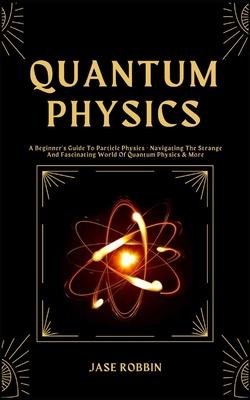
Book
Quantum Physics: A Beginner's Guide To Particle Physics - Navigating The Strange And Fascinating World Of Quantum Physics & More
by Jase Robbin
(Write a Review)
Paperback
$10.29
This particular branch of physics is indispensable for the comprehension of the physical universe. It provides a conceptual framework for understanding the characteristics and behaviors of particles at the quantum level, where the principles of classical physics cease to apply.
Quantum physics is comprised of the following fundamental concepts and principles:
- The phenomenon of wave-particle duality is observed in quantum particles, including electrons and photons, which manifest characteristics of both waves and particles. This duality presents a challenge to the traditional concept that particles follow unique classical trajectories.
- Energy Quantization: Energy is expressed in discrete units referred to as quanta. This is demonstrated by phenomena such as the photoelectric effect and quantized energy levels in atoms.
- Quantum Superposition: The simultaneous existence of multiple states is a property of quantum systems referred to as superposition. This is frequently demonstrated through the renowned thought experiment known as Schrodinger's cat.
- Entanglement: A phenomenon known as quantum entanglement occurs when particles become interconnected to the extent that their states are instantaneously correlated, despite the vast distances separating them.
- Uncertainty Principle: Position and momentum are two instances of pairings of attributes that, in accordance with this concept proposed by Werner Heisenberg, cannot be simultaneously known with absolute precision. As the precision of one property increases, the precision of the other property decreases.
- Quantum Tunneling: Particles have the ability to traverse energy barriers that are seemingly impenetrable according to classical physics. This phenomenon possesses ramifications across multiple disciplines, such as nuclear physics and electronics.
- Wavefunctions and Quantum States: The quantum system's state is characterized by a mathematical construct known as the wavefunction. The wavefunction provides data regarding the probabilities associated with locating a particle in various states.
Technological progress has resulted from quantum physics, including the creation of semiconductors, lasers, and specific medical imaging techniques. Furthermore, it serves as the foundation for quantum computing and carries significant ramifications for our fundamental comprehension of the essence of reality. Complex and frequently counterintuitive, the discipline challenges our traditional understanding of the physical world.
This particular branch of physics is indispensable for the comprehension of the physical universe. It provides a conceptual framework for understanding the characteristics and behaviors of particles at the quantum level, where the principles of classical physics cease to apply.
Quantum physics is comprised of the following fundamental concepts and principles:
- The phenomenon of wave-particle duality is observed in quantum particles, including electrons and photons, which manifest characteristics of both waves and particles. This duality presents a challenge to the traditional concept that particles follow unique classical trajectories.
- Energy Quantization: Energy is expressed in discrete units referred to as quanta. This is demonstrated by phenomena such as the photoelectric effect and quantized energy levels in atoms.
- Quantum Superposition: The simultaneous existence of multiple states is a property of quantum systems referred to as superposition. This is frequently demonstrated through the renowned thought experiment known as Schrodinger's cat.
- Entanglement: A phenomenon known as quantum entanglement occurs when particles become interconnected to the extent that their states are instantaneously correlated, despite the vast distances separating them.
- Uncertainty Principle: Position and momentum are two instances of pairings of attributes that, in accordance with this concept proposed by Werner Heisenberg, cannot be simultaneously known with absolute precision. As the precision of one property increases, the precision of the other property decreases.
- Quantum Tunneling: Particles have the ability to traverse energy barriers that are seemingly impenetrable according to classical physics. This phenomenon possesses ramifications across multiple disciplines, such as nuclear physics and electronics.
- Wavefunctions and Quantum States: The quantum system's state is characterized by a mathematical construct known as the wavefunction. The wavefunction provides data regarding the probabilities associated with locating a particle in various states.
Technological progress has resulted from quantum physics, including the creation of semiconductors, lasers, and specific medical imaging techniques. Furthermore, it serves as the foundation for quantum computing and carries significant ramifications for our fundamental comprehension of the essence of reality. Complex and frequently counterintuitive, the discipline challenges our traditional understanding of the physical world.
Paperback
$10.29